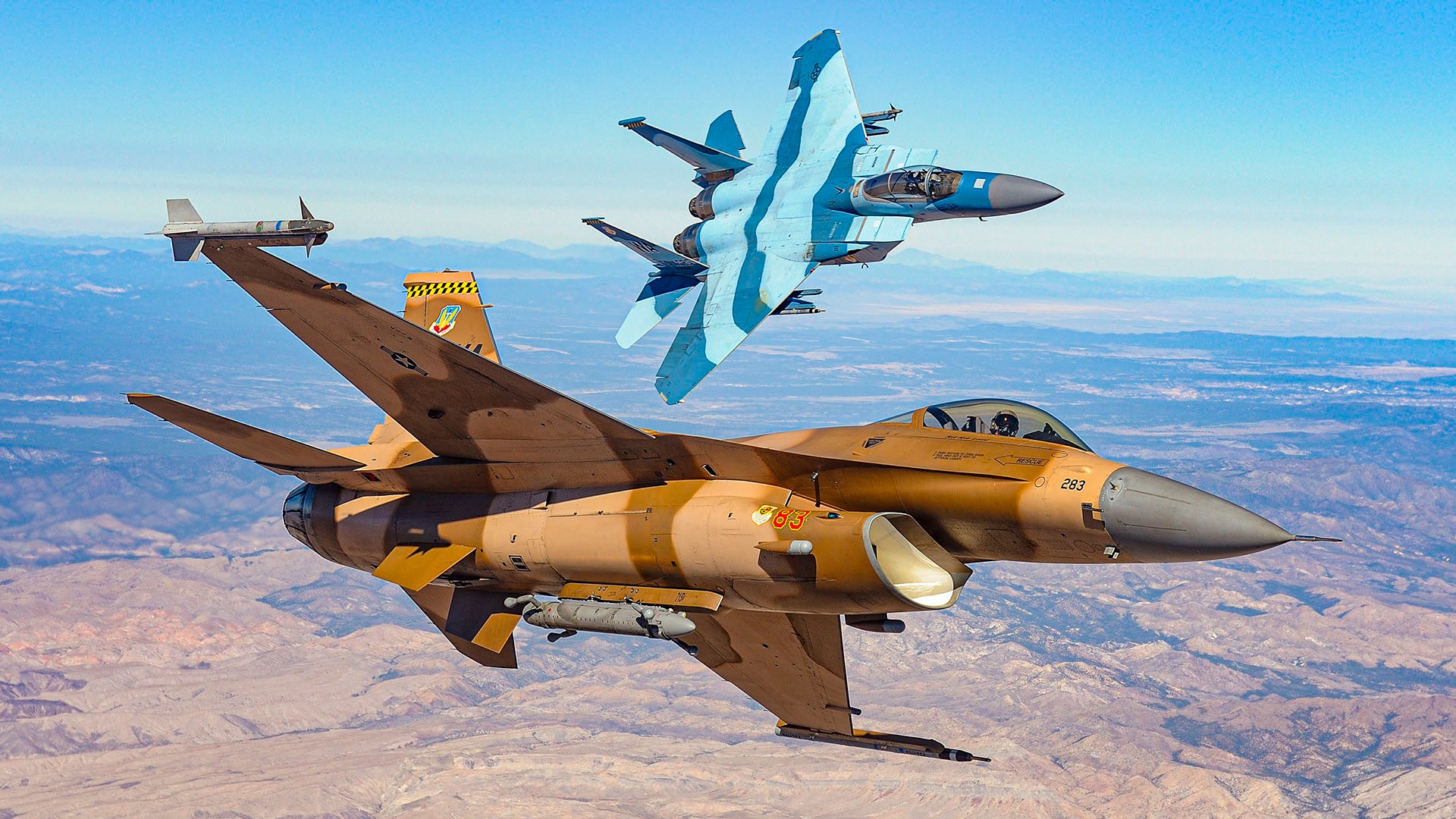The U.S. Air Force takes its aggressor forces very seriously indeed. They are considered to be vital training assets that keep operational squadrons sharp, at the tip of the spear, and ready for whatever threats may come their way. One particular pilot has unprecedented experience in this field, and in this exclusive and in-depth interview, he charts the history and the changing fortunes of the fascinating and clandestine aggressor world that is now in a period of dramatic expansion.
The aggressor world
Fighter aircraft types decked out in exotic paint schemes are becoming a more regular sight on military flight lines. It reflects a renewed emphasis on high-end training for fighter pilots to meet near-peer threats, such as those posed by China and Russia. This has spurred a huge increase in professional aggressor assets that support regular training. Aggressor forces include aircraft, systems, and skilled operators that offer realistic airborne presentations of potential enemy equipment, tactics, and techniques to expose front line aviators to the kind of engagements they could meet in real-world aerial combat.

It has become one of the most fascinating sides of modern military aviation, a booming industry for contractors, and a technology battle for in-house specialist squadrons, to be able to provide seamless replication of the wealth of high-end capabilities that are being fielded by possible adversaries. In 2016, the then commander of Air Combat Command General Herbert “Hawk” Carlisle said he wanted to outnumber F-22 Raptor and F-35 Lightning II pilots against an effective aggressor force by a factor of 3:1 or 4:1. Carlisle, a former aggressor pilot himself, said that pilots of fifth-generation aircraft needed to go up against radar-equipped adversaries and for so-called ‘red air’ to be able to hold their own in the visual, close-quarters fight, as well as the beyond-visual-range one. The result is an expansion in aggressor forces like never seen before, combining a mixture of organic and contracted solutions.
Aggressor training like this is nothing new — it stems from the U.S. Air Force’s Red Baron studies, which unpacked the air war over North Vietnam in extreme detail. They sought to understand why there had been such a marked change in the outcome of air-to-air engagements in the conflict. In the Korean War, USAF pilots achieved a 10:1 kill ratio over North Korean and Chinese adversaries, but by the Vietnam War, this dwindled. By 1968, the kill ratio was an appalling 2.5:1.
The Red Baron reports looked at every significant air-to-air engagement of the war, and what factors led to a win or a loss. A critical component in the performance of American pilots was determined as a deficiency in training against dissimilar types. Pilots almost always flew against their squadron mates, which meant they had little if any experience of fighting aircraft with different performance characteristics. Even fewer pilots had any experience of going up against equipment, tactics, or capabilities that emulated a potential enemy.
“The Red Baron study recommended fielding a professional aggressor force in order to make air combat training as realistic as possible,” explains Air Force Lieutenant Colonel Jan ‘Kuts’ Stahl, who is currently the deputy commander of the tenant 57th Operations Group at Nellis Air Force Base, Nevada. Nellis is known as “The Home of the Fighter Pilot,” and it’s here that the USAF focuses on making its Combat Air Forces squadrons as lethal as possible. As well as being home to the USAF’s elite Weapons School, and the famous Red Flag aerial wargames, it is also the home of the USAF’s aggressor forces.
Stahl has been an aggressor pilot for over a decade. He is one of the most experienced aviators with this background in the entire USAF, and a mine of information when it comes to replicating bad guys in the air. “I’ve been in the air force for 21 years now. When I initially entered the Air Force, I was lucky enough to be selected to train at Sheppard Air Force Base in Texas, which is also home to the Euro-NATO Joint Jet Pilot Training scheme, and is really the pinnacle for fighter pilot training here. Instead of going through training with an all-American crowd, I got to fly with our European and coalition partners.”
“I stayed at Sheppard as a FAIP [First Assignment Instructor Pilot] and during that time I made a lucky acquaintance with a seasoned German MiG-29 ‘driver’ who was also at Sheppard as an instructor. Unsure of which fighter community I wanted to go to, he said: ‘The F-15Cs kick our butts at Red Flag every time — you want to fly the C model.’ So I took his advice and selected Eagles, and was fortunate to get picked up for that.”
“I did two operational tours in the F-15C — with the 58th Fighter Squadron [FS] at Eglin and with the 95th FS at Tyndall — and right at the time I finished that second tour the F-15C footprint in the USAF was drawing down a little. This Limited my options on where I could go. I had the opportunity to join the 65th Aggressor Squadron flying F-15s at Nellis, and so I moved here in 2009.”
“Fast forward about three years and I made the transition from flying with the 65th as an active-duty pilot, to join the reserves and continuing to fly with that squadron.”

Genesis of the aggressors
In the wake of Red Baron, the USAF immersed a handpicked group of pilots, maintainers, and intelligence experts into a world of Foreign Materiel Exploitation (FME) to understand the mindset, the tactics, and the capabilities of principal adversaries. Air Force Systems Command (AFSC) was able to secretly acquire and fly a handful of acquired MiG-17s and MiG-21s from the late 1960s in order to fully understand their capabilities. The 64th Fighter Weapons Squadron (FWS) was established at Nellis in 1972, initially equipped with T-38 Talons and quickly becoming a training unit in high demand. The USAF subsequently formed the 527th Aggressor Squadron flying F-5E Tiger IIs at RAF Alconbury, in the United Kingdom, and the 26th Aggressor Squadron at Clark Air Base in the Philippines, as the aggressor mission gained steam.
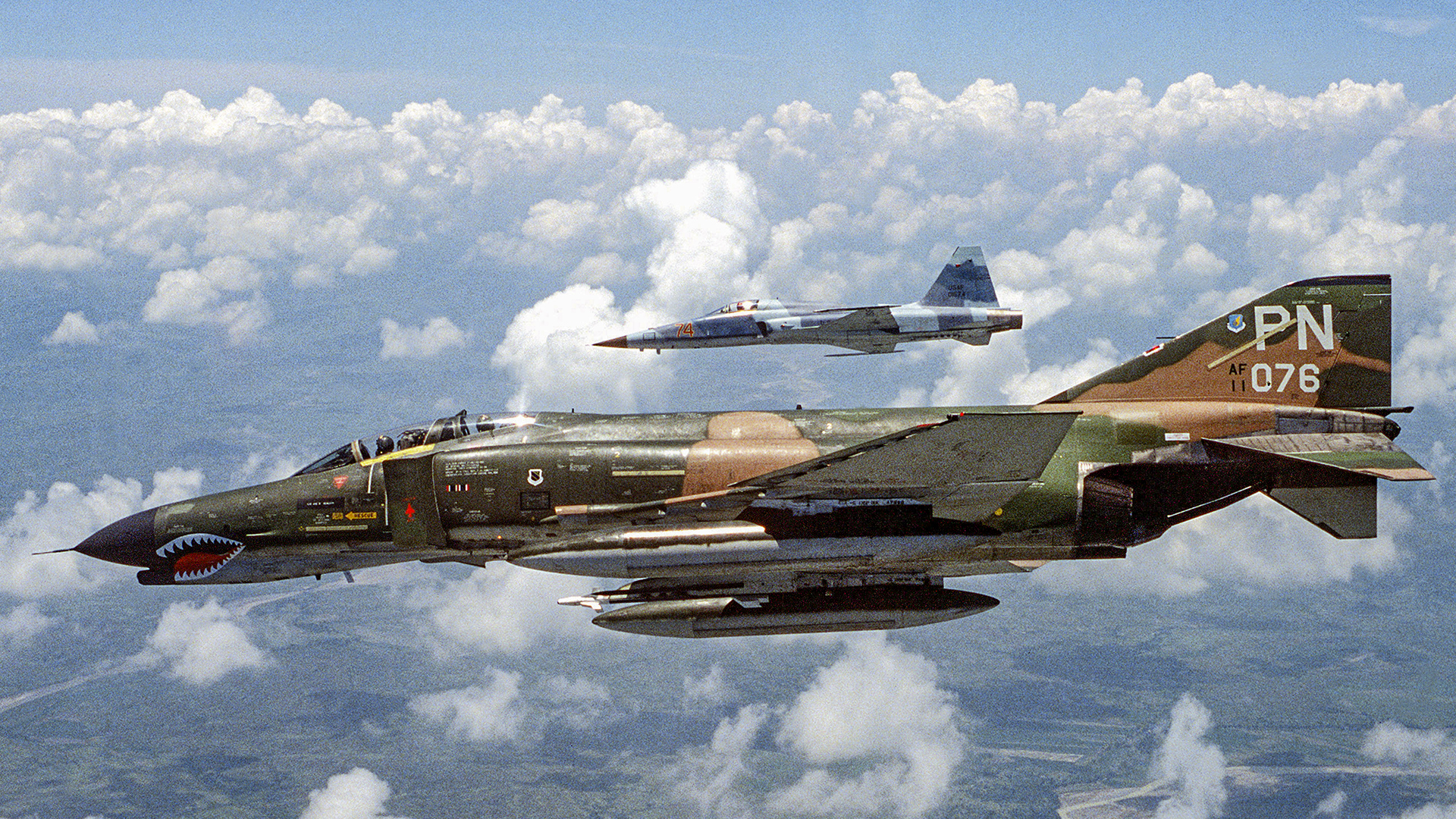
In 1977, Tactical Air Command (TAC) was allowed to take ownership of a handful of the MiGs in order to initiate the exposure of squadron pilots to these “assets” under a highly classified program known as “Constant Peg.” This was designed to take Dissimilar Air Combat Training (DACT) up another notch via the use of actual threat aircraft. You can read more about Constant Peg and the associated 4477th Test and Evaluation Squadron (TES) “Red Eagles” program here.
The initial cadre of aggressor pilots at the 64th FWS had access to the assets which enabled them to build their knowledge base and refine the threat presentations they provided. In addition, TAC squadron aircrews had the chance to experience flying against real Soviet aircraft during detachments or in special slots during Red Flag exercises.
“As Constant Peg was being fielded, the aggressors provided an additional layer of operational security for that program in the sense that there were several experienced aggressors that flew here at Nellis for two or three days a week, and who were then very quietly flown to Tonopah for the remainder of their duty periods to fly the MiGs up there,” Stahl confirms. “This provided a cover story to not only keep that program as operationally secure as possible, but it also generated additional credibility and skill level for the aggressors in the sense that those were the exact same guys that were actually operating the threat assets and knew better than anyone else what those airframes could actually do in the air.”
By the 1990s, the end of the Cold War and ensuing cutbacks started to severely impact the aggressors. Constant Peg officially wound down in 1988, followed by the 64th Aggressor Squadron (AGRS) in 2000. At one stage, the entire formal USAF red air program consisted of a handful of F-16s that were attached to the 414th Combat Training Squadron at Nellis. However, by 2003, the 64th AGRS was back in business, followed by the 18th AGRS at Eielson AFB, in 2007, to primarily support Red Flag Alaska. Both were equipped with early Block F-16C/Ds. In addition, the USAF was busy reactivating the 65th AGRS with F-15C/Ds, which would raise the bar once more for the USAF aggressors.

Becoming an aggressor
“The aggressor program has gone through a number of changes over the years,” says Lieutenant Colonel Col Stahl. “At the time I was selected, the bottom line prerequisite to join the aggressors was that you had to be a highly experienced instructor pilot, and not just that, the aggressors had a list of people who were potential candidates and they individually checked them — name by name vetting — to pick people who were not just qualified as instructors, but who also had the right attitude and the ability to not just want to win all the time, but to actually teach the blue air participants — those very subtle and detailed lessons learned against particular threats. I was lucky enough to get selected.”
“To become an aggressor — to a certain extent — you need to be a bit of a nerd. Interested and caring not just the airframe that you fly, but also the threat airframes. Part of the process is immersing yourself in that environment and being as smart as you possibly can about a particular topic. The air force picks up a new pilot or ground controller and selects a particular specialisation track for them.”
“For example, when I initially joined the aggressors, the chosen topic for me was air-to-air radar-guided missiles. This meant I went to our FME counterparts, saw the actual missiles taken apart and knew what each individual component part did and how it performed. I went to our intelligence counterparts at the CIA and at the National Air and Space Intelligence Center [NASIC] to put my head together with the best minds in the business to try to learn about that topic. They sent me to foreign trade shows in China, Russia, Belarus, you name it, so I could put eyes on these exact assets and try to learn as much about them as I possibly could.”
“It was a multi-year process; being as smart as possible on that topic, while also maintaining a baseline knowledge of other threat systems. It takes significant effort and expense to give the aggressors exposure to these systems. When you complete the process of certification you get a Russian Ruble [coin] with your name engraved on it — that’s how you distinguish an experienced aggressor from a newbie.”
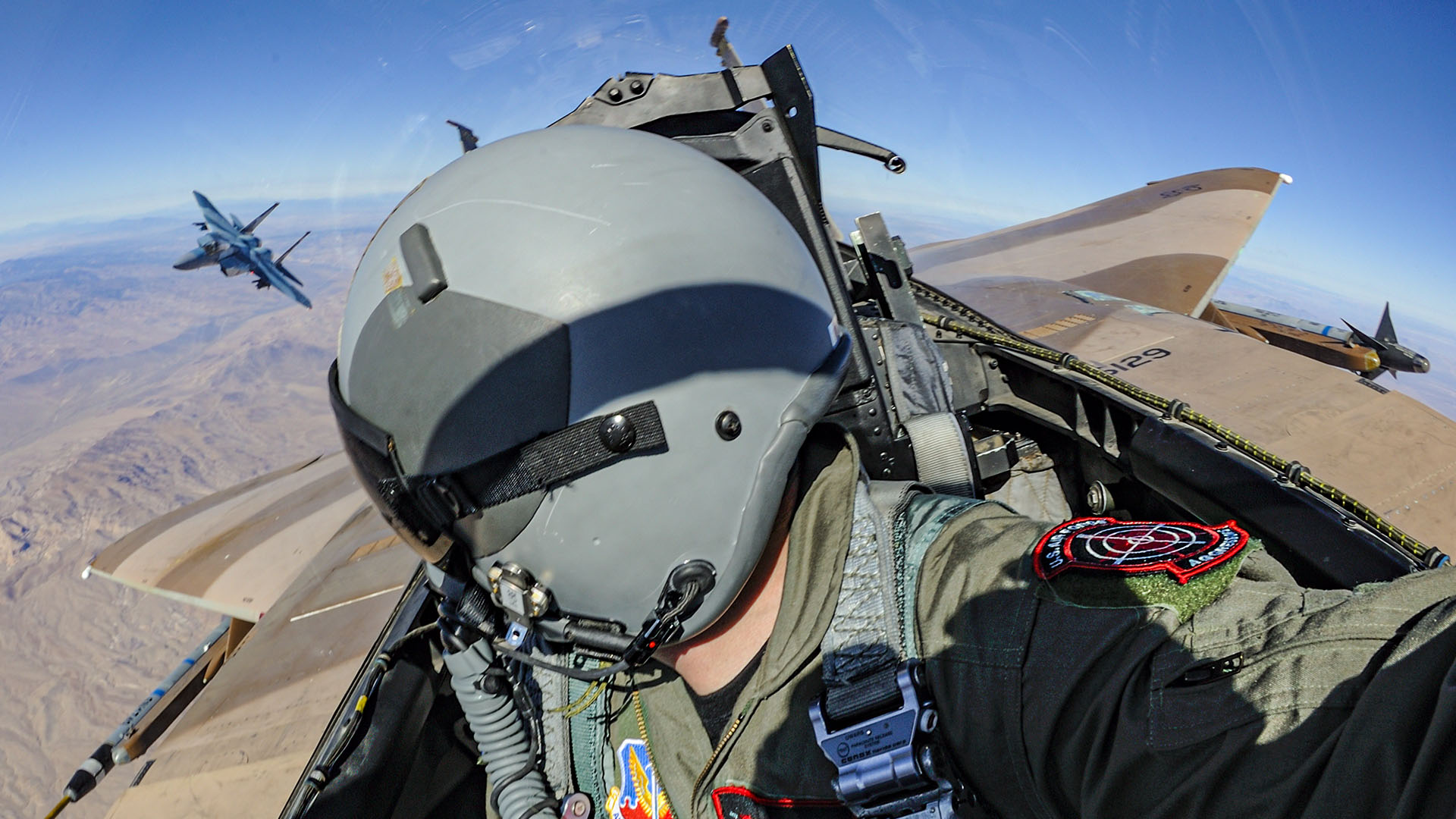
Stahl flew with the 65th AGRS to within six months of its deactivation in early 2014. “When the squadron shut down I could have either moved away to fly F-15s at another base, or if I wanted to stay at Nellis I had the opportunity to cross train to the F-16, either for the local aggressor program with the 64th, or into other Nellis-based activities like operational test with the F-16, which is what I ended up doing.”
Stahl then commanded the little-known 706th Fighter Squadron until 2019, which he explains is by far the largest fighter squadron in the entire USAF in terms of people, but doesn’t own any airframes of its own. “It’s also one of the few fighter squadrons that has pilots that fly every fighter MDS [Mission Design Series] in the service.”
The 706th is a reserve squadron that loans experienced aviators to the active-duty units at Nellis. “If a highly skilled, highly experienced, instructor pilot decides to leave the active-duty, we offer them the opportunity to switch patches and stay locally so we can continue to draw benefit on their experience and corporate knowledge — that’s what happened to me.”

A new era of expansion
The 65th AGRS ended up flying F-15C/Ds from 2006 until it closed its doors in 2014. That was a controversial decision ultimately driven by a dire budgetary situation. “It was a complicated story,” says Stahl. “With the international security situation, aggressors are always in high demand. The fact that Nellis wants to continue to field a challenging training environment that simulates those aggressive efforts to challenge the warfighting advantages that we have, means there needs to be a constant development in the quality of the focus we have here to train blue [forces]. Nellis needed aggressors more than ever at that time.”
“The F-35 footprint at Nellis was just beginning to get spun up at that point as well. We were going to need more aggressors, not less. The aggressors that we did have needed that next level of capability in order to provide a challenging sparring partner to the fifth-generation guys. It wasn’t a decision made easily — for budgetary reasons there was just no way to keep the unit open at the time. It was a decision that we are now having to deal with the after-effects of.”
“The combined, fielded, aggressor forces we have here at Nellis are barely able to fill 70 or so percent of what our optimal demand for adversary forces is. That’s what was leading the USAF to look at alternative courses of action such as contract aggressors, as well as inviting visiting units from elsewhere to come and help us out.”

“Because of the demands that you put on the adversaries here at Nellis, it was clear from the get-go that we weren’t going to be able to shut down a unit like the 65th and immediately replace it with something equivalent. The fielding of contract aggressor forces was always intended to be a multi-year process in which initially we put jets on the line to fill more of the demand for quantity as opposed to the demand for quality. We then put measures in place that over a period of multiple years to stimulate the contract adversary industry to put some of these specific requirements and demands that we need in order to meet that quality benchmark, as well.”
“At the moment I think we’re still in the early stages of that process, but there’s some really promising signs that — in the near future — we’re going to get some fairly significant capability increases from what the contractors are offering us. That’s going to take some of the strain off some of the USAF aggressors, which I would say are the ultimate low density, high demand assets that we have here.”
The USAF is ultimately looking to stimulate the red air contractors to gradually build to a point where they’re financially and operationally able to field airframes of higher and higher capability. “The Air Force was deliberate to not put all the eggs in one basket, and split the contracts up to see which of them was going to be more successful in continuing to ramp up the capabilities that they are able to field,” explains Stahl. “The contracts also break adversaries down into various capability levels, because what you need for a trainee flying their first couple of flights in say an F-16 is not the same as you need for an F-22 Weapons Officer.”
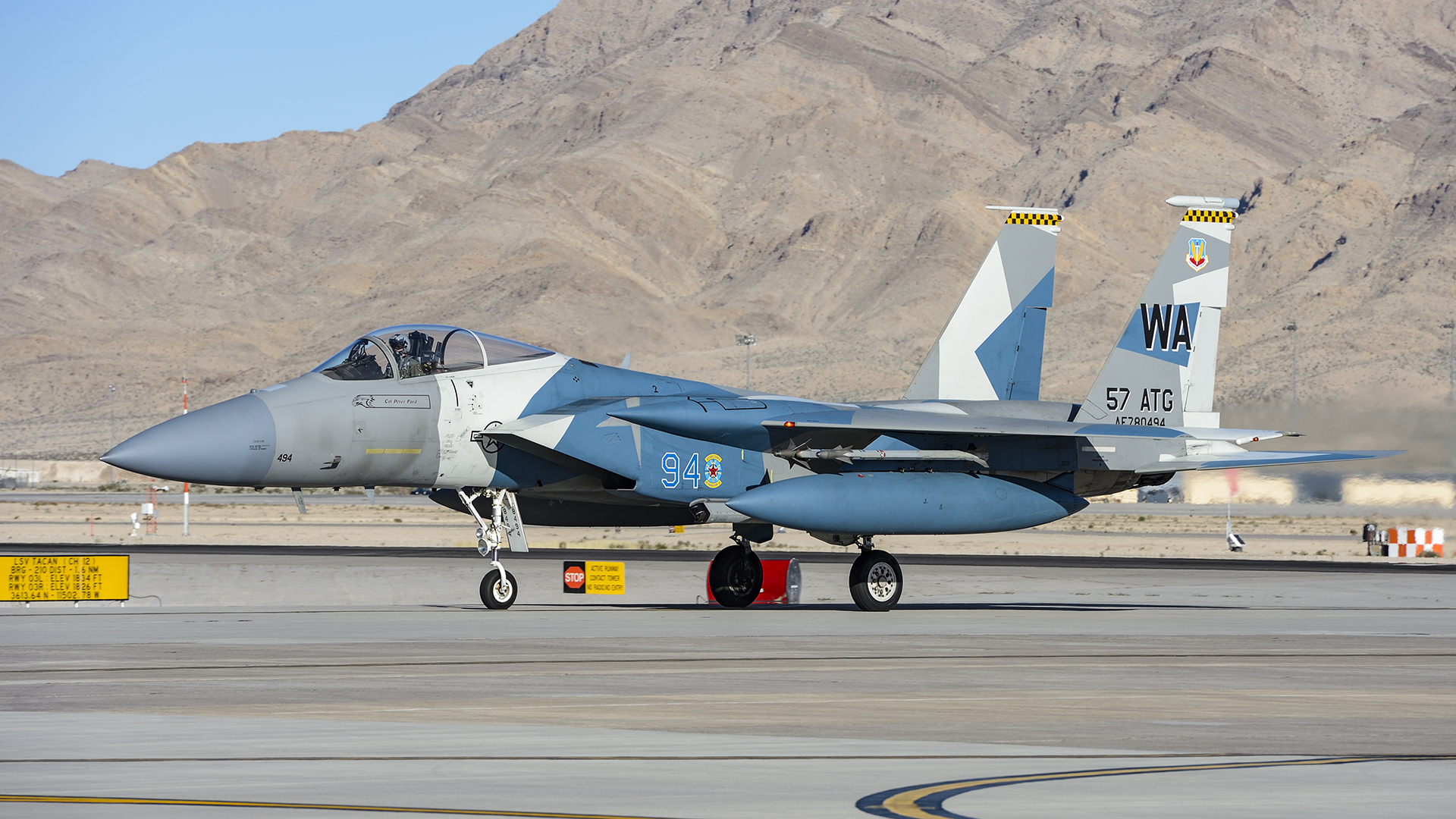
“The Air Force is offering a lower entry level aggressor, which allows some companies to come in with a fairly low upfront investment to get into the contract and be able to generate revenue. Then they are gradually raising capabilities to levels that the company can progress into. Based on what we’ve heard here, there’s a lot of companies out there that have some really exciting capabilities that they’re working on. They need to get their foot in the door and start making revenue, then starting making the investment.”
“The Weapons School is our central coordinating authority here, because they take up most of the aggressor demand at Nellis. They apportion who does what, who does the 64th AGRS support, who does Draken International support, or do we support together. Managing the contracts and ensuring the contractors meet those quality benchmarks is where the aggressors come in. We lead the missions that they are part of, and we also run the post-mission reviews of performance, and ensure they comply with demands and tactical learning points that we required them to provide.”

Aggressor developments at Nellis
As well as leaning on the contractor-furnished solutions, the USAF is pushing up the high-end capabilities of its in-house aggressors. It plans to increase the size of the 64th AGRS, and reform the sister 65th AGRS in 2021.
Internal USAF reorganization has resulted in a decision to close down the 24th Tactical Air Support Squadron (TASS), which flies Vipers at Nellis. The unit is currently a centralized location for training F-16 Close Air Support (CAS) instructors and for retaining a dedicated close air support knowledge base. Its closure has presented a good opportunity to move its Block 42 F-16C/D Vipers over to the aggressors.
“We currently have 19 pre-Block F-16s [Block 25 and 32] and the game plan is to take over an additional 11 Block 42 F-16s,” says Stahl. “Initially, when the 24th TASS shuts down, the 64th AGRS is going to become a very large squadron, but there are efforts underway to reactivate the 65th AGRS — around the summer of 2021 — when we split those assets into two units to make them a bit more manageable,” Stahl explains.
The 64th will probably retain the Block 25/32 aircraft, and the aircraft from the 24th TASS will most likely flow over to the 65th AGRS as that unit is reactivated. “That’s when it gets really interesting, because that’s when the early Block F-35s start arriving here at Nellis and move into the 65th AGRS which then becomes a mixed F-35 and F-16 aggressor squadron,” Stahl enthuses. “It’s still in a bit of flux, but I think it’s fair to say that summer 2021 is when we expect to see those first F-35s [here at the aggressors].”
“The goal for the aggressors has always been where we are essentially matching the aggressiveness of our global competitors. They are fielding technology at a rapid pace and our goal has always been to match and if possible exceed that level of technological advancement — so the threat we are preparing the warfighter for locally exceeds anything that they’re ever likely to face in battle. Not necessarily just from a technological standpoint but also from the employment standpoint. We’re here to have the technology, then employ it to its highest level so we’re presenting the highest that we can possibly put together.”
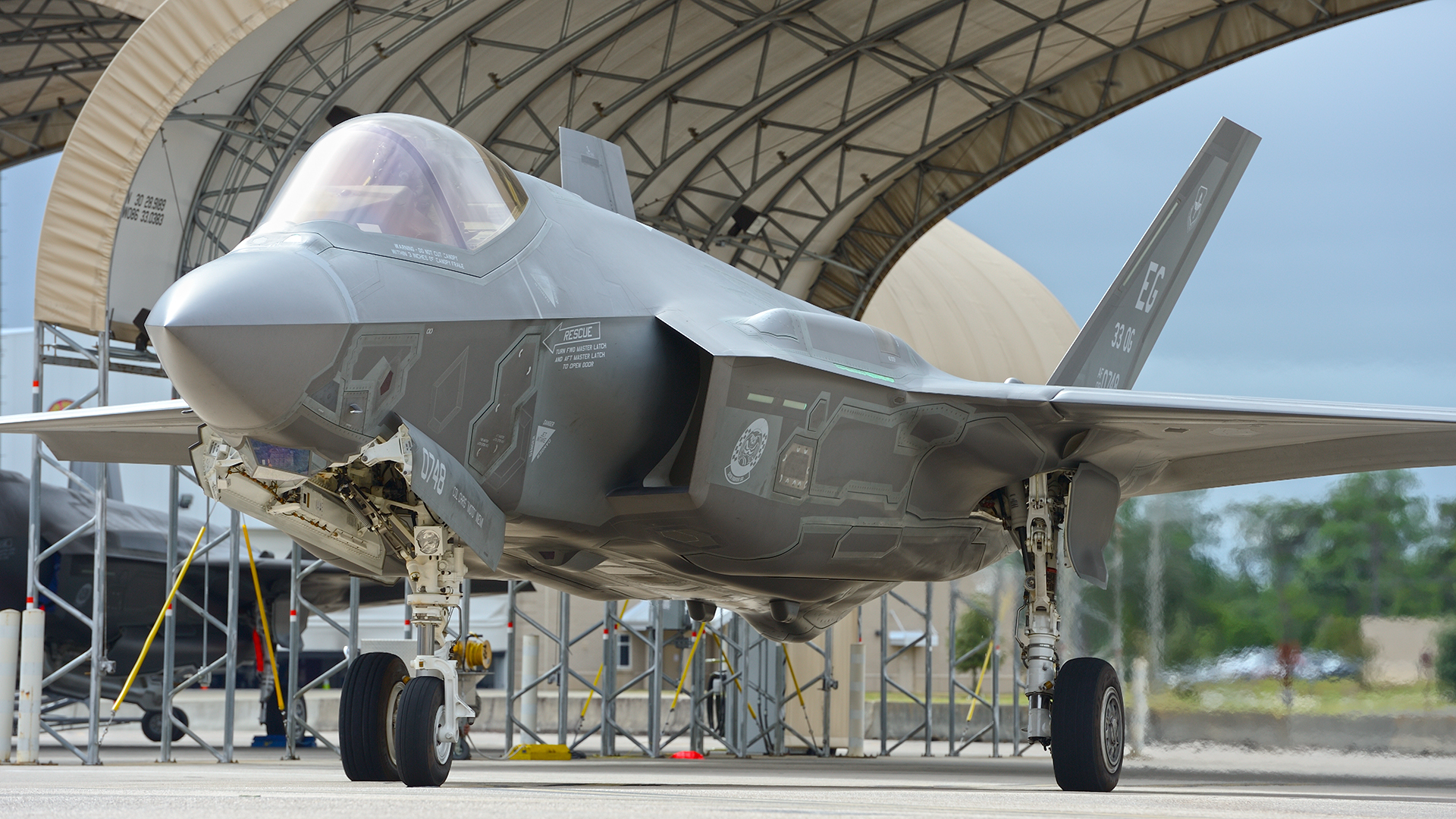
Alongside the F-35s, the introduction of Block 42 F-16 Vipers will bring additional benefits for the aggressors. Their Link 16 data links will be an early boost for the USAF aggressors at Nellis. Some of the current F-16s with the 64th AGRS carry the SADL (Situational Awareness Data Link), which serves as an intra-flight link between the aggressors. Link 16 will enable the new 65th AGRS adversaries to make use of a full battlespace picture, and operate more independently as a coordinated team, instead of a more traditional approach of working with Ground Controlled Intercept (GCI) controllers.
It’s also worth noting that the F-35A has a Multifunction Advanced Data Link (MADL), which interfaces with Link 16 via a gateway, so it can receive information from the Vipers while remaining fully stealthy and it can share information, as well. One of the advantages of MADL is that it is stealthy by design due to its transmission architecture. F-35 also has organic Link 16 broadcast capability, but using it can negate the aircraft’s stealth capabilities.
Instead of targeting fleetwide capabilities, the aggressors are able to dip into new areas of technology to add small niche capabilities to help them replicate specific real-world threats. One of the 64th AGRS F-16s flew with a pod very similar to the Legion infrared search and track (IRST) pod in 2013, and Stahl says work has also been undertaken with Litening and Sniper targeting pods to simulate IRST capability.
The Block 42 F-16 avionics architecture is also more readily able to support the fielding of new systems, such as the Angry Kitten pod, which was recently adopted by the 64th AGRS. This pod incorporates advanced Digital Radio Frequency Memory (DRFM), which is the highest complexity jamming technology and can counter increasingly sophisticated electronic warfare threats. The Operational Flight Program (OFP) in the later block F-16s is more frequently updated and readily able to accept enhancements that can help keep the aggressors relevant.
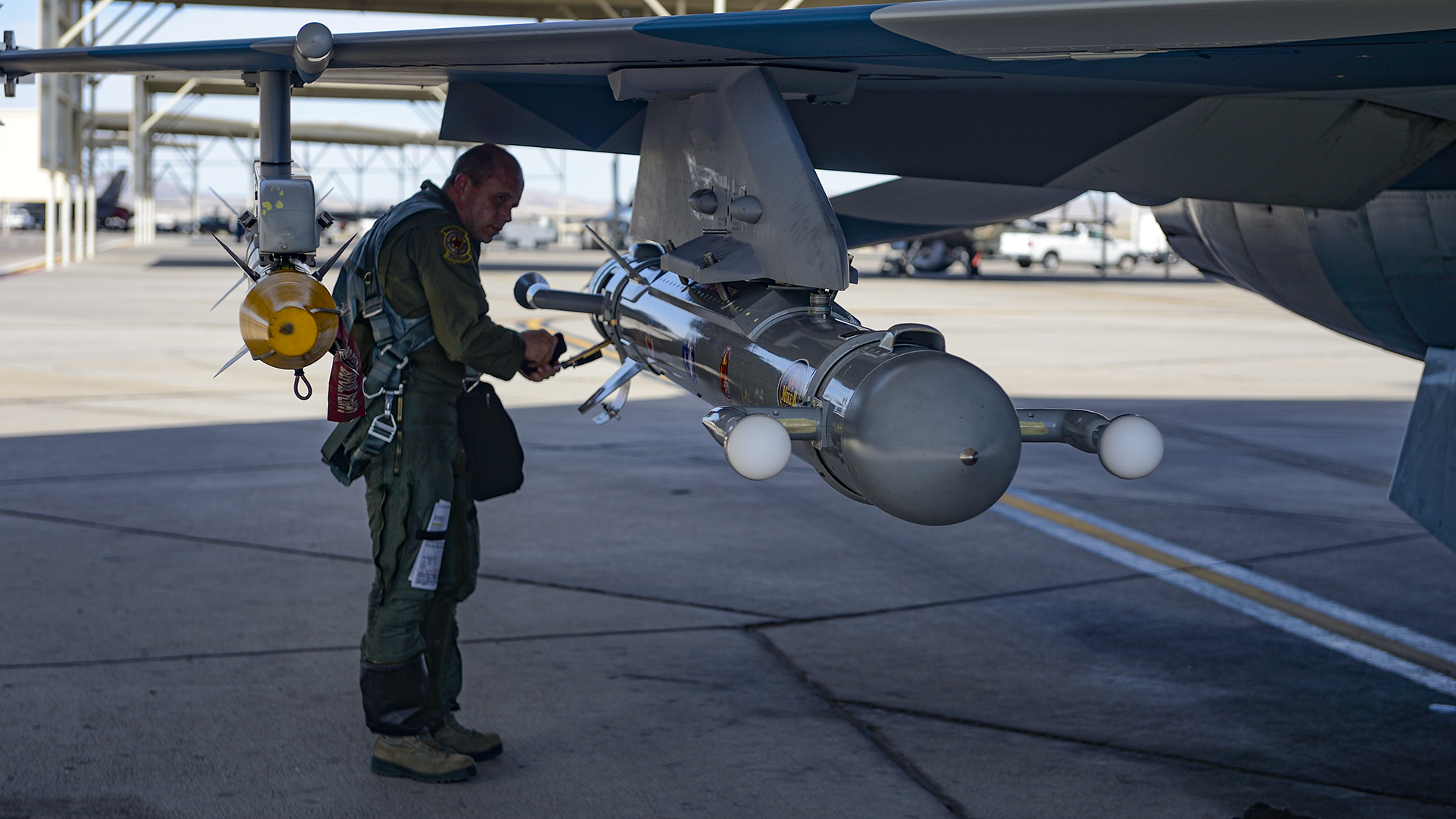
An Active Electronically Scanned Array (AESA) radar is another capability that the aggressor F-16s would benefit from, as increasing numbers of threat aircraft have these advanced sensors. The USAF is already fielding new Northrop Grumman AN/APG-83 AESA radars in its F-16 fleet, and Stahl says for the aggressors; “it’s a capability that has to happen sooner or later.”
New threats, new ways to replicate
So how does a modern day F-16 aggressor pilot learn how to fly in a way that accurately replicates the nuances of a Chinese J-20 Mighty Dragon, for example. Stahl says: “You need to know how the system operates, and how the pilot operates in that particular system. So, when we’re looking at the J-20, for instance, there as much emphasis on trying to look inside the mind of the Chinese pilot. What caliber of person they’re recruiting to fly that asset, the background those pilots are from, what they flew before and experiences they’re likely to have had, where they’ve been based, what operational scenarios they are trained to.”
“Every once in a while the stars align and a particular asset that we want to know more about becomes available for us to actually touch. For instance, I was lucky enough to have the once in a lifetime opportunity to fly the Su-30MKI when the Indian Air Force came to Red Flag Alaska in 2016. If you want to get smart about how a Flanker operates, that’s about as good as it gets. Obviously, as aggressors, we position ourselves when opportunities like these become available to ensure we’re ready for it and take advantage of it. We take what we can get. Flying the Su-30 was definitely a pinnacle in my career.”
Other methods to bring accurate threat replication to USAF pilots are coming via synthetic training, either in simulators, or in embedded virtual constructive training scenarios. “The biggest emphasis the Air Force is currently trying to get the operators to agree to is that the future lies in Live, Virtual and Constructive [LVC] integration,” explains Stahl. “It’s not so much about which environment and medium in which we do the bulk of our training, but which medium is best suited to train to specific capabilities that we need the operator to have. For instance, threat countries are coming up with next-generation missile capabilities that allows you to take air-to-air shots at ranges that even 10 years ago we would never have even considered.”
‘We want to simulate and train to those capabilities, but we start to running into things like airspace limitations. The Nevada Test and Training Range [NTTR] is literally not long enough to allow us to simulate the full range capability of some of these weapons that we have to train against. Now you get into a situation where other mediums are better suited for training against that specific capability, and the challenge is how you tie all these mediums together.”
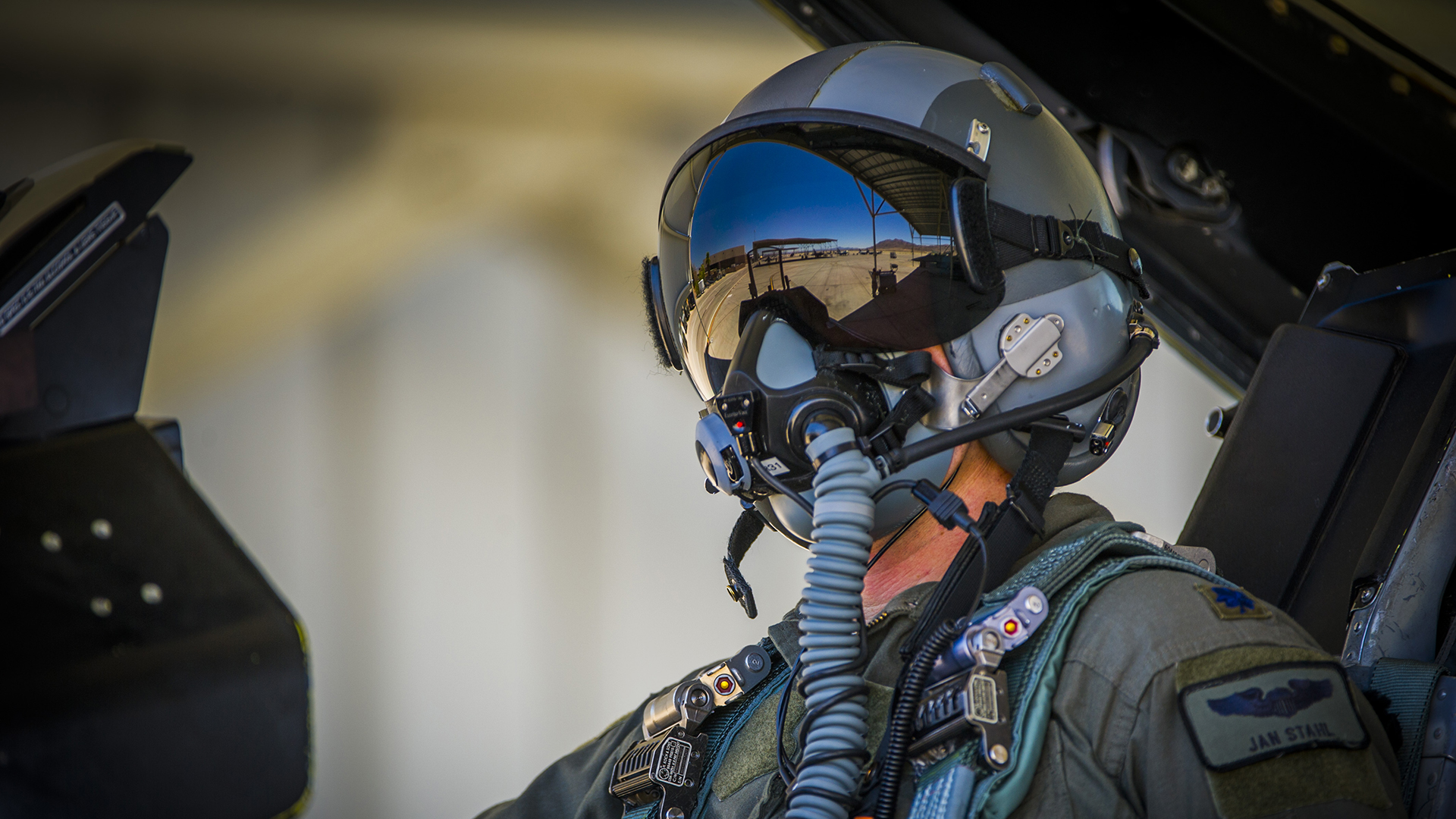
“The live part is what we do in jets. The virtual is where we take actual operators and get them to work their platforms in a simulator. The constructive element is where you have threat entities actually simulated by a computer system — simulated entities inside a simulator system — that’s what we hope to be able to do as we refine LVC, blend them seamlessly with some of the live and virtual. If I take my jet into the NTTR, where I can see some of the virtual and constructive entities simultaneously with the real world elements I’m training against, and now we see these next generation threats.”
One of the nodes that will tie together and enable some of this LVC is currently in progress at Nellis. The Virtual Test and Training Center (VTTC) is spearheading this charge. “Initial steps are already in place,” says Stahl. “At higher level exercises like Weapons School Integration and certain Red Flags, virtual and constructive is a significant part of what we do, because of the complexity of the threat we are being asked to simulate. The goal of the VTTC is to afford more simulation infrastructure here. The trick is to tie [the various technologies] together where they talk to each other and become visible to one another in their own architectures, and how they then become relevant to simulate a particular capability or particular threat that we need to train against.”
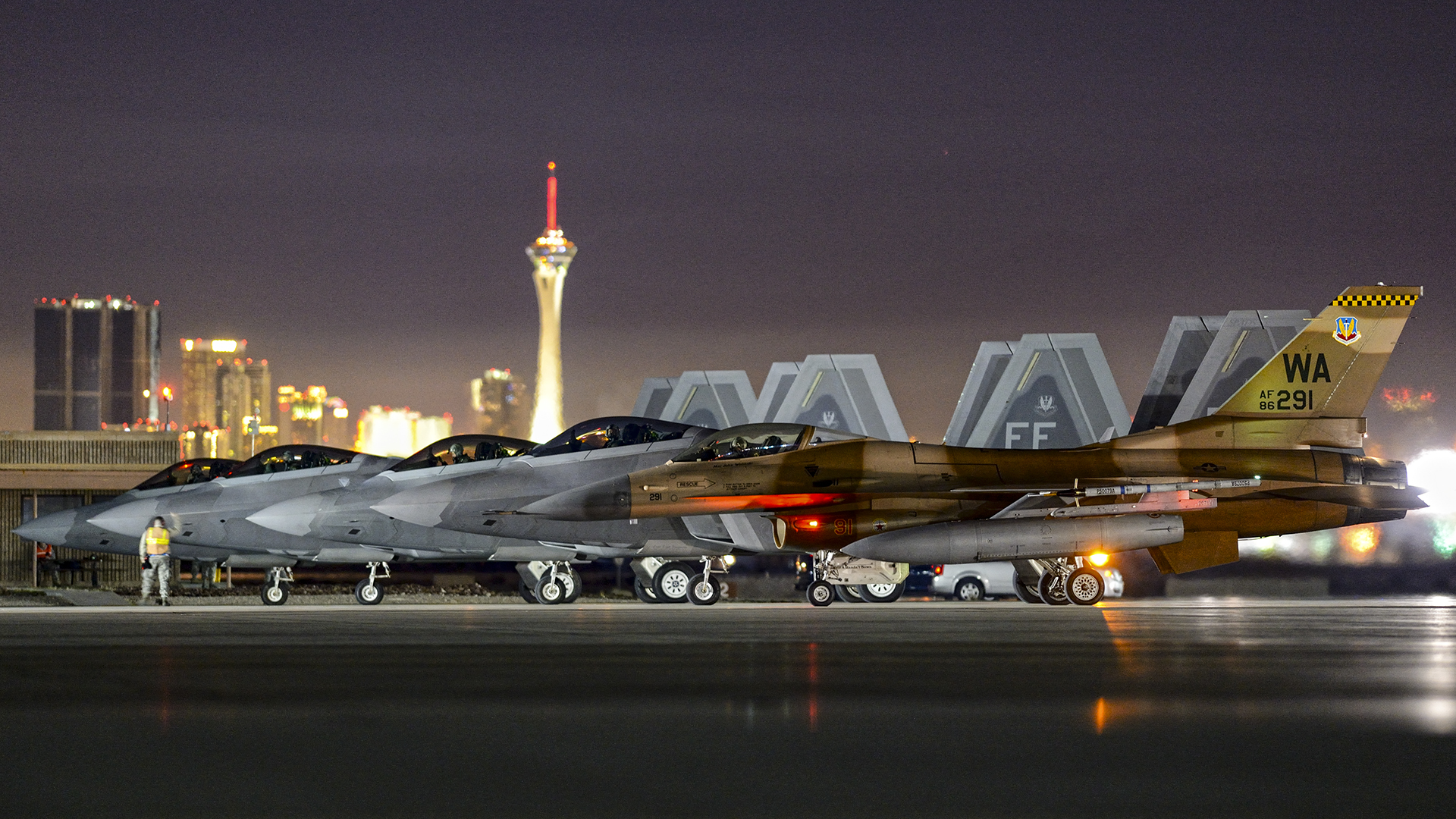
A constant evolution
The use of advanced simulations will undoubtedly be one of the biggest changes in the way the aggressors operate. However, the vast majority of current training is dedicated to live flying. Stahl says the main evolution he has seen in the aggressors has been a focus from pure DACT (dogfighting) towards maximizing the integration of assets, both on the blue and red air sides of the house.
“On the blue side, we try to provide a threat that not only challenges individual airframes, but also the ability for those to work together. We have tried to come up with counter-tactics that specifically challenge the 4th and 5th gen integration. Say you have four Raptors and four Eagles trying to employ in the air-to-air environment at the same time, we have to come up with specific counter tactics that challenge the way that they work together, and the tactics they use.”

“On the red side, it means we have to work very closely together, for example with our surface-to-air-missile shooters on the range, and try to come with tactics that involve both of those elements working in close conjunction. For example, we might put the fighters forward and keep the SAMs quiet, then maybe pull the fighters back and light up every SAM battery — there’s a significant amount of integration and interplay that we can achieve, but it requires that next-gen mindset. Not just in the narrow lane of your own capabilities, but how to best bring them all together into one coherent threat picture that gives blue as big of a challenge as possible.”
In addition to the missiles and fighters, this also includes the cyber and space domains, which Stahl says massively increases complexity. “I’d say this is the biggest way in which our mission has evolved in the last couple of years. This is such a fast-moving ballgame, capabilities are being fielded all the time and some quickly become obsolete.” Stahl explains that the aggressors’ knowledge of threat capabilities in these areas are extremely high.
Turning back to the aircraft themselves, Stahl says the proliferation of 5th generation stealth fighters has had a big impact on the mission. “This has significantly changed the way we do business, in the sense that there’s really nobody else in the world that’s doing as much training using 5th gen assets as we are. So, we are having to take a bit of a leap of faith and make our own assumptions regarding what an adversary would possibly do when faced with a 5th gen adversary. We are making assumptions in a 5th gen vs 4th gen engagement, and a 5th gen vs 5th gen environment now that we have the F-35s coming online with the aggressors as well.”

“There’s a level of guesswork for realistic scenarios as to what could happen, but as Russia comes online with the Su-57 Felon and China with the J-20, we are watching those developments very carefully so we can make informed decisions on how we can tweak the scenarios locally to make them as relevant to what’s going on in threat countries as we possibly can.”
As to the most rewarding missions as an aggressor, Stahl reflects on the time he led a 48-aircraft red air “package” that included 12 different platforms. “Being “MiG-1” for a 48-ship mission in a Red Flag and seeing the game plan come together was amazing. To present a challenging threat, you have to expand your situational awareness as much as you possibly can so that when merges [dogfights] happen, even if you don’t see everybody, you have the awareness of who is in that merge with you. Are they high or low, which way are they heading, how your turn performance will match? It’s like three-dimensional chess at 1,000 mph, and it takes many years to get good at it.”
Contact the editor: Tyler@thedrive.com
